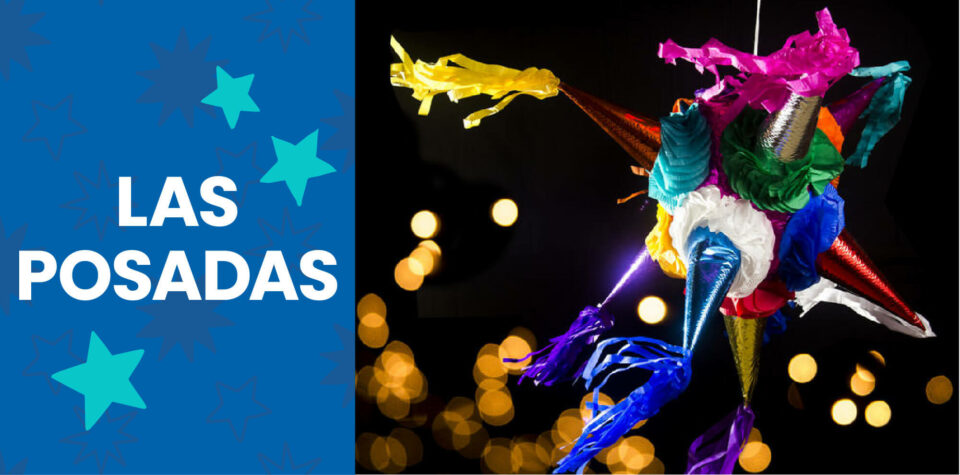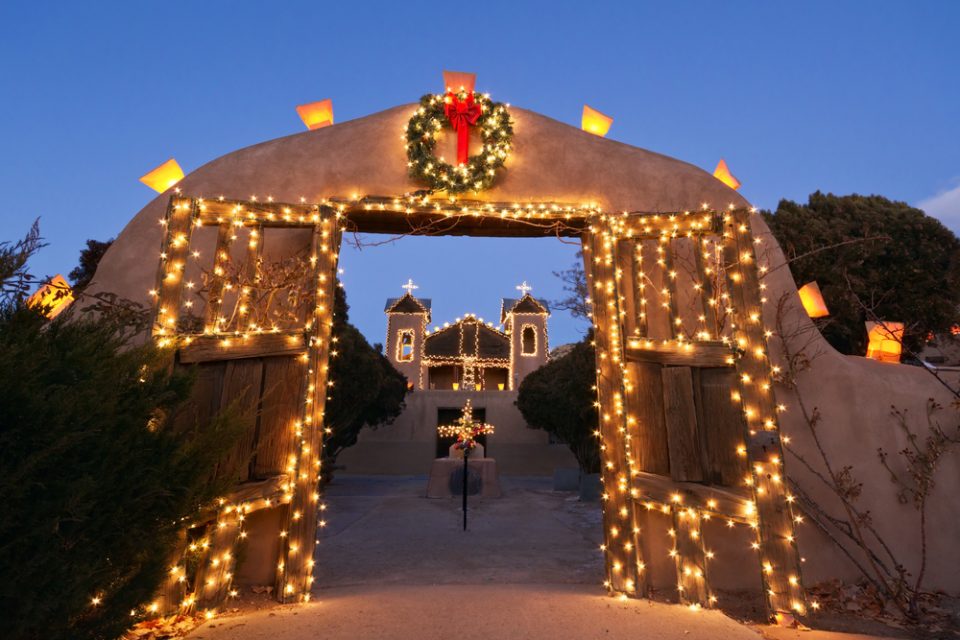
Las Posadas: A Mexican Christmas Tradition for the Whole Neighborhood
Around the world, different cultures celebrate a variety of holidays during the winter months. In Mexico, the festive season begins on December 12 with Día de la Virgen de Guadalupe (Day of the Virgin of Guadalupe) and continues until El Día de Los Reyes Magos (Three Kings’ Day) on January 6. An additional celebration, Día de la Candelaria (Candlemas), takes place on February 2. There are a number of wonderful Christmas traditions in Mexico during this time, but among the most notable are posadas, religious festivals that bring communities together in the streets.
This holiday season, help instill an appreciation for new places and traditions in your children by teaching them about posadas. You can do so by sharing the cultural importance of the festival, learning the “Pidiendo Posada” song, and crafting a traditional Christmas piñata to celebrate the holiday.

What Are Posadas?
Posadas are a series of fiestas navideñas (Christmas parties) that traditionally take place December 16–24 in many Latin American countries, including Mexico, Guatemala, Honduras, and Cuba. Many people of Latino heritage in the U.S. also partake in the tradition. For the devout, las posadas are an important part of Roman Catholic Christmas festivities because they commemorate the story of Jesus’s birth in the Bible.
According to the Bible, Mary and Joseph couldn’t find lodging the night Jesus was born. Eventually, an innkeeper let them stay in a nearby stable—which is why many nativity scenes show Jesus in a manger surrounded by farm animals.
In Mexico, many people reenact this search for lodging by forming a procession and traveling to a different home each night of las posadas. At the head of the procession are children dressed as Mary, Joseph, and an angel. Other children may wear biblical attire and carry pictures of Mary and Joseph while adults and musicians follow behind.
Along the way, the group stops at several houses and sings a song asking for shelter—neighbors open their doors to refuse “Mary and Joseph” but provide the group with refreshments. Finally, the group arrives at a designated home (or church), where they are let in for a big party. The children break open piñatas, usually in the shape of a star, filled with candy and toys.
What Is the “Pidiendo Posada” Song?
When Spanish Catholic missionaries came to Mexico in the 1500s, they used posadas to teach the indigenous people about the birth of Jesus. One way they shared the nativity story was with “Pidiendo Posada” (“Asking for Shelter”), a song many Mexicans still sing during modern celebrations. Several versions have come to exist over the centuries since the tradition began, each with slightly different lyrics. Despite the variations, the melody and the storyline remain the same.
The song has two parts, one sung by the people inside the homes, who represent innkeepers, and the other by the pilgrims outside, who symbolize Mary and Joseph looking for lodging. The back-and-forth singalong of short verses begins with the pilgrims (representing Joseph) begging the innkeepers to take pity because Mary is about to give birth, and they have nowhere to stay:
En nombre del cielo pedimos posada, pues no puede andar mi esposa amada.
(In the name of heaven, we ask for lodging, for my beloved wife cannot walk.)
The innkeepers refuse and urge them to continue their journey and seek shelter elsewhere:
Aquí no es mesón. Sigan adelante. Yo no debo abrir. No sea algún tunante.
(This is no inn. Go onward. I mustn’t open the door. You could be trouble.)
But the pilgrims persist, saying Joseph is a carpenter and they have traveled very far—from Nazareth—and that they are no ordinary guests:
Posada te pide, amado casero, por sólo una noche la reina del cielo.
(The queen of heaven is asking for shelter, dear lord of the house, just for one night.)

The innkeepers respond by questioning what sort of queen would be traveling alone and if she is a queen, who are asking on her behalf. The pilgrims (speaking again as Joseph) reply:
Mi esposa es María, es reina del cielo, y madre va ser del Divino Verbo.
(My wife is Mary, queen of heaven, and she will be mother of the Divine Word.)
At long last, the innkeepers realize who is at the door, and things take a turn for the better for the expectant couple:
¿Eres tú, José? ¿Tu esposa es María? Entren, peregrinos, no los conocía.
(Is that you, Joseph? Your wife is Mary? Come in, pilgrims. I didn’t recognize you!)
The doors finally open, and the pilgrims and hosts all sing in unison:
Entren santos peregrinos, peregrinos, reciban este rincón, que aunque es pobre la morada, la morada, os la doy de corazón.
(Come in, holy pilgrims. Receive this corner, for though this dwelling is humble, I give it to you from my heart.)
To end, all the pilgrims, now inside, give thanks by singing the closing lyrics:
Mil gracias os damos que en esta ocasión posada nos disteis con leal corazón. Pedimos al cielo que esta caridad os premie colmándoos de felicidad.
(A thousand thanks we give you for giving us shelter with a loyal heart. We ask heaven that this charity reward you by showering you with happiness.)

Las Posadas Food
After all the walking and singing, it’s time for a warm, hearty meal. Luckily, the host household happily provides. Food is an essential element of posadas (as it is with many Mexican holidays, like Independence Day).
A Mexican posada often includes dishes like tamales (a corn-based dough stuffed with meat or beans and cheese) and ponche navideño (Christmas punch made with dried fruits, sugarcane, and cinnamon).
Make Your Own Piñata
One of the highlights of Christmas in Mexico for kids, typical to many posadas, is the tradition of breaking piñatas. These brightly decorated paper (or pottery) containers are filled with candy, small toys, and fruits, and they come in many different shapes, sizes, and colors. Piñatas are common at parties in Mexico year-round, but what makes piñatas navideñas (Christmas piñatas) special is their seven-pointed star shape and vibrant strands of paper that dangle from each point. The game is simple: Children tie on blindfolds and take turns hitting the suspended piñata with a long stick. When it breaks and the contents spill out, everyone rushes in to collect the goodies.
Like posadas, piñatas originated in Mexico during the 1500s, and now they’re used in many celebrations around the world. But there’s no need to travel far to partake in the fun. Together, you and your children can make your own by following this simple guide.
Materials
- 1 small cardboard box that can be taped shut
- Packing tape
- Colorful paper (such as crepe paper, tinsel garland, or patterned cupcake liners)
- Nontoxic glue
- Child-safe scissors
- Piñata filling (small toys, candy, and other treats)
- String or ribbon
- A stick or baseball bat
Directions
- Seal up all the openings of your cardboard box with tape, then use the box to make the basic shape of your piñata.
- Kids decorate the outside of the box by gluing the colored paper onto it. Get creative with fringe, tassels, and other festive touches!
- When the box is covered in paper, an adult creates a small hole at the top using scissors. Fill the piñata with candy, toys, or other treats.
- An adult cuts two small incisions on either side of the hole at the top of the box. Tie the string or ribbon through the holes to create a loop. This is how you’ll hang the piñata.
Hang the piñata somewhere with lots of open space, such as outside on a tree branch. Then, help your kids use a stick to whack the piñata until it bursts and the treats fall out. Just be sure everyone stays at a safe distance while each person takes their swings.

Bring World Cultures Home with Little Passports
Posadas are one unique way people celebrate holidays around the world, but they’re just one of many. Are you and your young explorers ready to continue your festive journeys? Learn all about global celebrations with our award-winning World Edition subscription box. Each month, your children will receive hands-on activities, stories, and more relating to a different country that will inspire a love for faraway people and places. Finding each country on the included world map is sure to spark your child’s curiosity—and might inspire your next family vacation!
This holiday season, give your children the gift of knowledge and let them experience the wonders of the world from the comfort of home.

